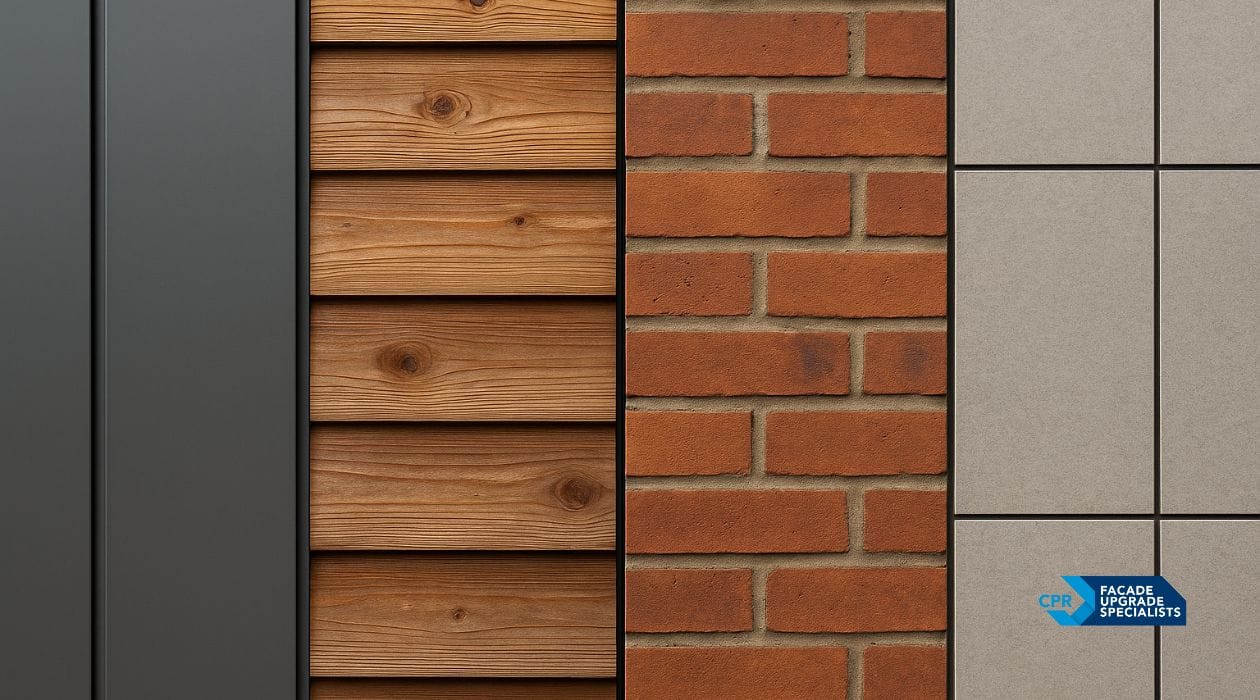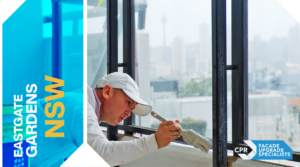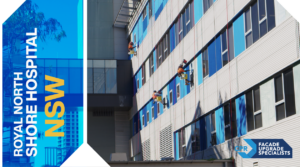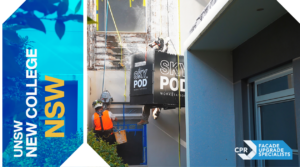Building facades are more than just appearances; they protect, insulate, and define the character of a property. The right cladding system can transform both the performance and aesthetic of your building. In this guide, we explore the different types of cladding available today — their benefits, applications, and how CPR’s Scaffold-Free™ methodology ensures safer, more cost-effective outcomes for strata and commercial buildings alike.
The right cladding system can transform both the performance and aesthetic of your building
What Is Building Cladding and Why Is It Important?
Building cladding is a material layer fixed to the exterior of a structure to provide protection against environmental elements, enhance insulation, and improve aesthetics. Beyond its visual appeal, cladding is a key factor in energy efficiency, noise reduction, and building longevity.
Cladding systems act as a barrier against weather, moisture, and UV radiation while providing a refined finish that elevates a property’s market value. In modern high-rise and strata buildings, exterior wall cladding contributes significantly to sustainability and fire safety outcomes, making informed material choices essential.
The 6 Main Types of Cladding for Modern Buildings
Each cladding material offers distinct properties in terms of durability, cost, maintenance, and appearance. Here are six of the most widely used building cladding materials.
Understanding the right material is only part of the process — achieving compliance is equally critical. That’s why CPR’s Cladding Rectification and Compliance Works ensure every system aligns with Australian regulations like AS 5113.
1. Metal Cladding Panels
Metal cladding panels – such as aluminium, zinc, and steel – are popular for their strength, longevity, and weather resistance. They create a sleek, contemporary look ideal for commercial and industrial buildings.
Benefits:
- Highly durable and weather-resistant.
- Low-maintenance cladding requiring minimal upkeep.
- Available in various finishes (powder-coated, perforated, or brushed).
- Reflective surfaces can enhance energy efficiency.
For large-scale or difficult-access projects, CPR utilises Scaffold-Free™ access systems like MARS™ and PEARS® to install and maintain metal cladding efficiently — which means for you, reduced downtime, no intrusive scaffolding, and a cleaner, faster result.
2. Timber Cladding
Timber cladding remains a timeless choice for natural beauty and sustainability. It offers warmth and texture, often used in mixed-material facades or eco-friendly designs.
Benefits:
- Natural, sustainable aesthetic.
- Lightweight and easy to install.
- Can improve thermal insulation.
However, timber requires regular treatment to prevent rot and fading. For modern building facades, treated or composite timber options are often chosen to maintain performance over decades.
3. Stone Cladding
Stone cladding adds sophistication and permanence. Natural stones such as granite, sandstone, or limestone are long-lasting and create a luxurious finish.
Benefits:
- Exceptional durability and energy-efficient cladding performance.
- Resistant to fire and temperature extremes.
- Premium look that boosts property value.
Though heavier and more expensive than other materials, CPR’s SkyPod® workstations allow for safe installation even on high-rise structures without scaffolding — which means for you, reduced cost and disruption during the process.
4. Brick Cladding
Brick cladding combines tradition with versatility. It mimics full-brick construction but uses thin veneer panels, reducing weight and installation time.
Benefits:
- Fire-resistant and low-maintenance.
- Excellent thermal performance.
- Suitable for heritage refurbishments and modern builds alike.
Brick cladding systems are often used in facade remediation to preserve character while enhancing energy efficiency and safety. CPR’s SKY-FIMMS™ documentation system tracks every brick panel replacement, ensuring transparency and traceability for compliance.
5. Vinyl Cladding
Vinyl cladding is a lightweight, cost-effective solution available in many colours and finishes. It’s often used in refurbishments or secondary facades.
Benefits:
- Affordable cladding with fast installation.
- Minimal maintenance.
- Good resistance to moisture and UV exposure.
While vinyl is less durable than metal or fibre cement, CPR’s inspection process under SFS360® (Sky Facade Scope 360™) ensures optimal material performance and installation accuracy for every project.
6. Fibre Cement Cladding
Fibre cement cladding combines sand, cement, and cellulose fibres to achieve excellent durability, insulation, and fire resistance. It can replicate the appearance of wood or stone at a fraction of the cost.
Benefits:
- Composite cladding that is non-combustible.
- Resistant to rot, termites, and fire.
- Low-maintenance cladding with a clean, modern finish.
It’s a preferred option for strata and commercial applications seeking balance between affordability and long-term performance.
How to Choose the Right Cladding for Your Building
Selecting the right facade cladding system depends on several factors:
- Location and climate: Humid or coastal environments demand corrosion-resistant materials like aluminium or fibre cement.
- Building use: Commercial properties may prioritise durability and design impact, while residential strata buildings value cost and maintenance ease.
- Budget: Balance upfront cost with long-term value and maintenance savings.
- Aesthetics: Choose a finish that complements the building’s architecture.
Through CPR’s Facade Consultation Service, property owners can receive a SKY-FIMMS™ report to visualise every option in a 3D model before making decisions, ensuring data-backed choices and peace of mind.
Benefits of Using Quality Cladding Systems
Investing in quality cladding offers both functional and financial rewards:
- Protection: Shields from moisture, UV, and pollutants.
- Energy efficiency: Reduces heating and cooling costs.
- Longevity: High-grade systems last for decades with minimal upkeep.
- Value increase: Enhances market appeal and strata resale value.
CPR’s Scaffold-Free™ technology ensures that all installations and upgrades are completed faster, safer, and with up to 20% cost savings, while maintaining award-winning quality.
Professional Cladding Installation and Maintenance
Correct installation is crucial to performance and compliance. Poor workmanship can lead to water ingress, corrosion, or structural damage.
CPR’s Accredited Service Partners™ are certified under the PEARS® Elevation Training Academy, ensuring consistent quality across every project. Using Upseiling® techniques, our team performs rope-access maintenance and inspections without scaffolding — which means for you, minimal disruption, zero privacy intrusion, and a safer working environment for everyone.
Our after-sales program, AssetCare™, provides ongoing maintenance and periodic inspections to extend facade life and maintain compliance.
Related Blog Posts
- What is Rope Access and Why It Matters in Building Maintenance
- How to Maintain Exterior Cladding for Long-Term Performance
- The Importance of Anchor Points for Rope Access Safety
- Top Materials for Sustainable Facades
Final Thoughts
Choosing the right cladding materials is about more than looks — it’s about performance, safety, and long-term value. Whether you manage a strata property or oversee large-scale remediation projects, CPR delivers the data-driven expertise and Scaffold-Free™ systems that redefine facade care.
Looking to upgrade your building’s exterior? Book a consultation or request a SKY-FIMMS™ demo to see how our innovative approach can save time, cost, and stress.






